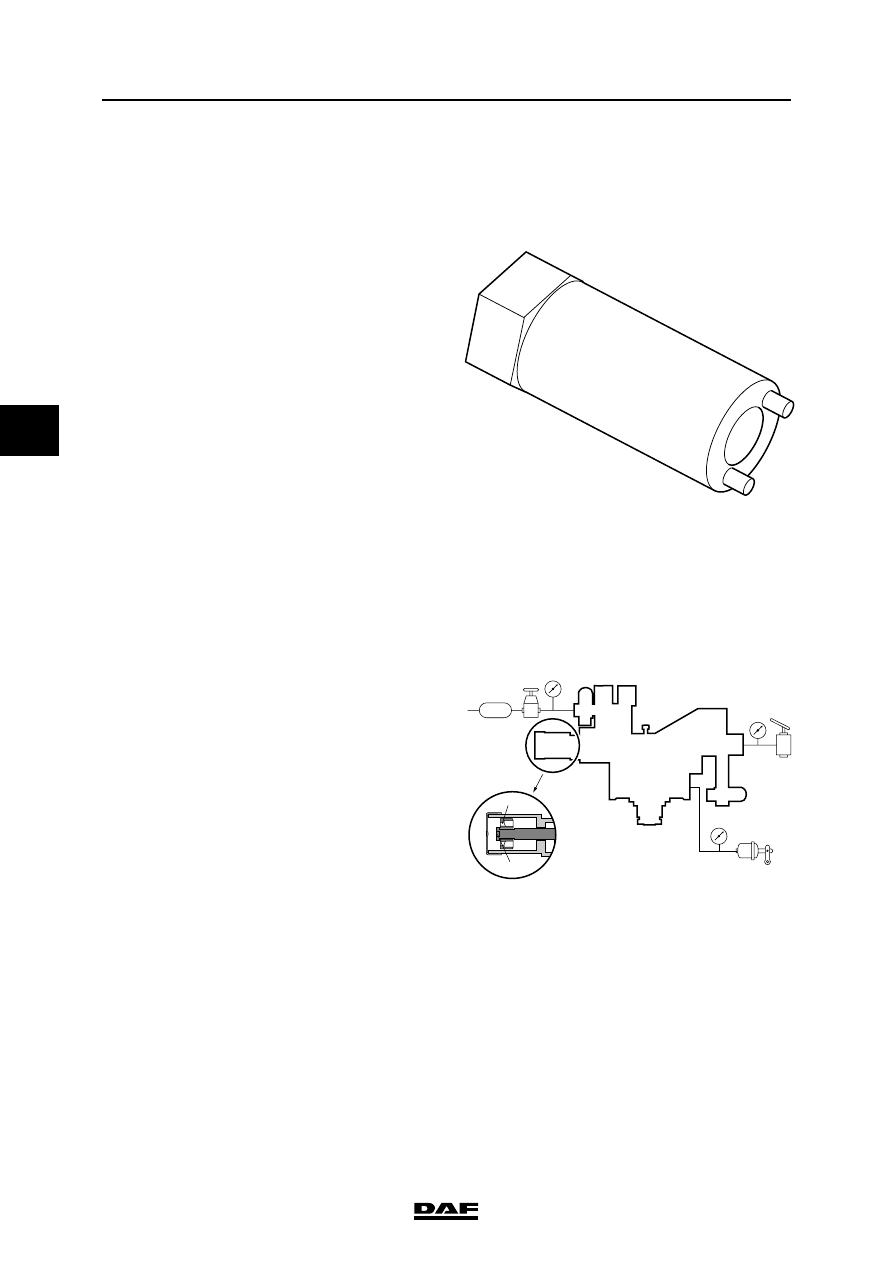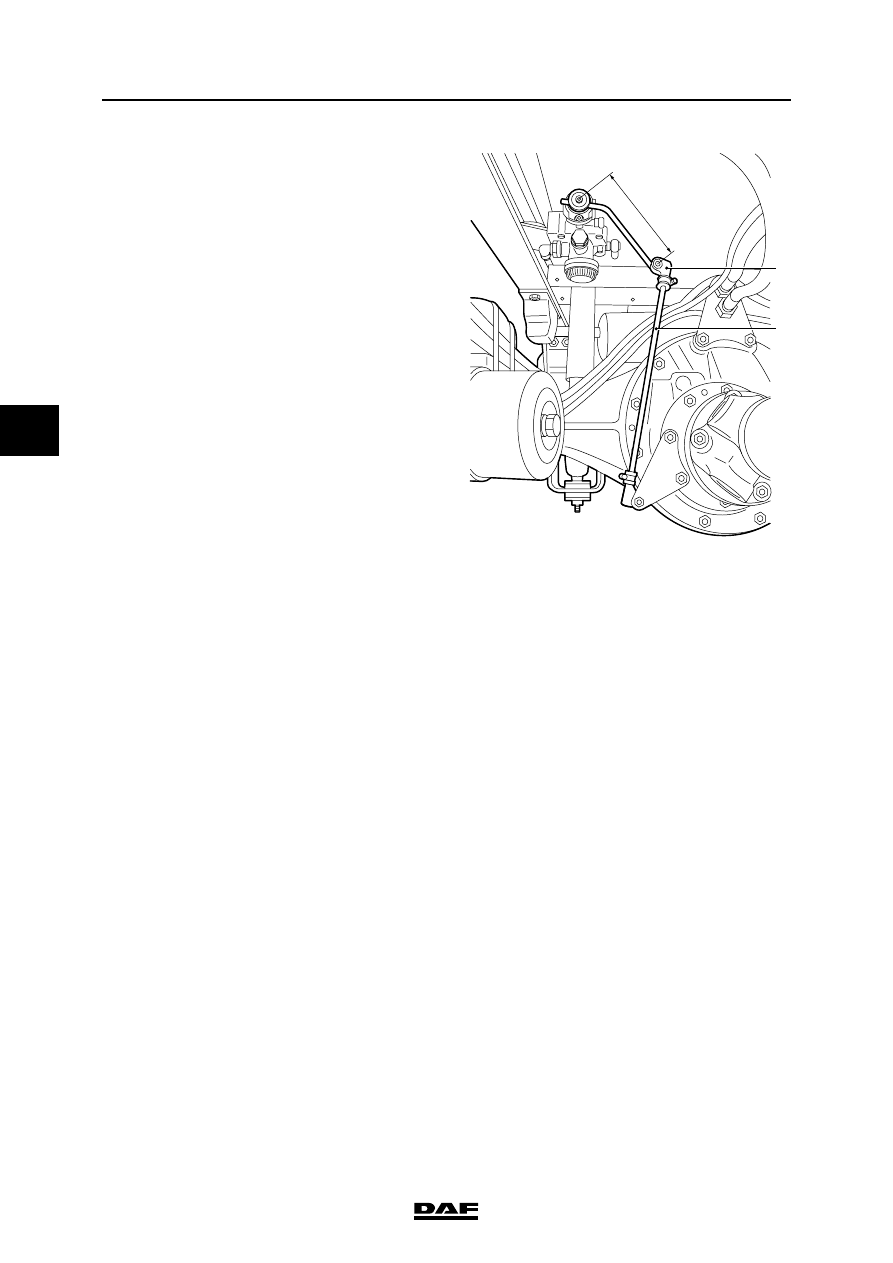DAF LF45, LF55 Series. Manual — part 456

©
200436
2-3
Inspection and adjustment
BRAKE SYSTEM AND COMPONENTS
ΛΦ45/55 series
6
4
2.3 INSPECTION AND ADJUSTMENT, LOAD SENSING VALVE, AIR
SUSPENSION
Explanatory notes on instruction plate
The information contained on the plate relates to
the axle loads, the output pressures and bellows
pressures, in accordance with the order of axles
beneath the vehicle.
"1" refers to the (first) front axle, "2" to the
following axle, etc.
In the entire column, a reading of 6 bar has been
filled in under "1".
If the vehicle is equipped with an empty/load
valve, a pressure ratio is entered in the box under
the valve illustration, e.g. "i = 1 : 1.5". The
"delivery pressure p2" of axle "1" then indicates
variable readings.
These values can be used to check the brake
pressure values of the front axle and to carry out
the inspection/adjustment below at the same
time. To do this, connect a pressure gauge to the
test connection of one of the front axle brake
cylinders.
Inspection/adjustment
1.
Check that the correct valve has been fitted
(see instruction plate).
2.
Connect pressure gauge 4 to the test
connection close to connecting point 1/4 on
the load-dependent control valve (input
pressure).
3.
Connect pressure gauge 2 to the test
connection on one of the brake cylinders
(service brake connection) of the rear axle.
4.
Connect a pressure gauge (43) with a
pressure-reducing valve to the simulation
connection near connections 41 and 42 of
the load-sensing valve (= simulated
adjustable bellows pressure).
5.
Make sure that the reservoir pressure is
higher than 6.5 bar throughout the testing
process.
6.
Set the simulated bellows pressure to its
second lowest value, as indicated on the
instruction plate.
7.
Depress the brake pedal until pressure
gauge 4 indicates a pressure of 6 bar.
R6 00 548
43
1/4
4
2
2
R600473
1
41 42
r
s

BRAKE SYSTEM AND COMPONENTS
2-4
©
200436
Inspection and adjustment
4
ΛΦ45/55 series
6
8.
Read the brake pressure of the rear axle on
pressure gauge 2 and check that this brake
pressure matches the one listed on the
instruction plate in the table under "output
pressure p2" to the rear axle.
9.
If the measured value is not correct,
depressurise connection 43 and, using a
special slotted-nut spanner, special tool
(DAF no. 1329464), turn the adjusting nut(s):
-
brake pressure too high: unscrew the
adjusting nut
-
brake pressure too low: screw in the
adjusting nut
Note:
When depressurising the simulation
connection (pressure gauge 43), the air hose
must remain connected to prevent the
(actual) bellows pressure from accidentally
activating the valve.
The small socket head screw in the centre of
the valve must not be adjusted.
10. Repeat the procedure described in point 6
until the measured brake pressure value is
within the tolerance limits.
11. Set the simulated bellows pressure to its
second highest value, as indicated on the
instruction plate.
12. Depress the brake pedal until pressure
gauge (4) indicates a pressure of 6 bar.
13. Read the pressure gauge (2) and check that
this braking pressure matches the pressure
indicated in the table on the instruction plate.
14. If the measured reading is not correct,
depressurise connection 43 and turn the
adjusting bolt (r) using a Torx screwdriver:
-
brake pressure too high: screw in the
adjusting bolt
-
brake pressure too low: unscrew the
adjusting bolt
Note:
When depressurising the simulation
connection (pressure gauge 43), the air hose
must remain connected to prevent the
(actual) bellows pressure from accidentally
activating the valve.
The small socket head screw in the centre of
the valve must not be adjusted.
15. If the adjusting bolt (r) has been turned,
repeat the procedure from point 6.
R600478
43
1/4
4
2
2
R600473
1
41 42
r
s

©
200436
2-5
Inspection and adjustment
BRAKE SYSTEM AND COMPONENTS
ΛΦ45/55 series
6
4
2.4 INSPECTION AND ADJUSTMENT, LOAD SENSING VALVE,
LEAF SUSPENSION
Explanatory notes on instruction plate
The data relating to axle loads and output
pressures are listed on the instruction plate
following the sequence of the axles beneath the
vehicle.
"1" refers to the (first) front axle, "2" to the
following axle, etc.
In the entire column, a reading of 6 bar has been
filled in under "1". If the vehicle is equipped with
an empty/load valve, a pressure ratio is entered
in the box under the valve illustration, e.g.
"i = 1 : 1.5". The "output pressure P2" of axle 1 will
give variable readings.
These values can be used to check the brake
pressure values of the front axle and to carry out
the inspection/adjustment below at the same
time. To do this, connect a pressure gauge to the
test connection of one of the front axle brake
cylinders.
Inspection/adjustment
1.
Measure the weight plus load of the rear
axle.
2.
Check the attachment of the control lever
and its ease of operation.
3.
Check that the right type of valve has been
fitted.
4.
Check the length of the control lever (see "L"
on the instruction plate).
5.
Connect a pressure gauge (4) to the test
connection near connection 1/4 on the load-
sensing valve (input pressure).
6.
Connect a pressure gauge (2) to the test
connection on one of the brake cylinders
(service brake connection) of the rear axle.
7.
Make sure that the reservoir pressure is
higher than 6.5 bar throughout the testing
process.
8.
Depress the brake pedal until pressure
gauge 4 indicates a value of 6 bar.
9.
Read the brake pressure of the rear axle
from pressure gauge 2 and check that this
value matches the one listed on the
instruction plate in the table under "output
pressure p2" to the rear axle.
R6 00 549
1/4
4
2
2
R600562
1

BRAKE SYSTEM AND COMPONENTS
2-6
©
200436
Inspection and adjustment
4
ΛΦ45/55 series
6
10. If necessary, correct the brake pressure by
adjusting the length of the vertical
connecting rod (2). Never attempt to alter
length L of the (horizontal) control lever.
11. Remove the ball coupling (1) and raise the
control lever. Check that the output pressure
is now allowed through (almost) without
reduction.
Note:
The small socket head screw in the centre of
the valve must not be adjusted.
1
2
R6 00 568
L

Нет комментариевНе стесняйтесь поделиться с нами вашим ценным мнением.
Текст